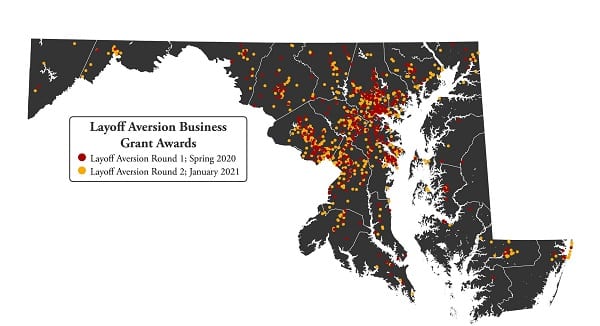ANNAPOLIS, MD—Governor Larry Hogan on Wednesday announced that the Maryland Department of Labor’s COVID-19 Layoff Aversion Fund has saved 21,555 jobs and supported 1,267 small businesses through two rounds of funding, totaling over $31 million. One of several relief programs originally introduced by the governor in March 2020 and expanded through additional funding in October 2020, the COVID-19 Layoff Aversion Fund has enabled the state to provide financial assistance to help Maryland small businesses avoid layoffs and closures.
“The state has delivered more than $1.7 billion in emergency relief for Maryland’s struggling families and small businesses, including over $31 million for the tremendously successful Layoff Aversion Fund,” said Governor Hogan. “Labor’s Layoff Aversion Fund provided a critical lifeline, funding nearly 1,300 small businesses in every county across the state, keeping their doors open for business, and saving over 21,500 jobs during these unprecedented times.”
The first round of funding announced in March 2020 awarded over $10 million in grants to 445 small businesses and saved 8,819 jobs. The second round of funding announced in October 2020 awarded over $21 million in grants to support 822 small businesses and save 12,736 jobs across the state. Combined awards from both rounds of funding invested more than $31 million back into the state’s economy.
“We are very thankful to Governor Hogan for expanding the COVID-19 Layoff Aversion Fund and to our team at Labor for quickly approving applications to provide our state’s struggling small businesses with much-needed funding to adapt their business models and keep Marylanders employed,” said Labor Secretary Tiffany P. Robinson. “The success stories and overwhelmingly positive feedback from grantees and their employees give us hope in these challenging times.”
Grantees used the average award size of $25,725 for needs such as purchasing remote access equipment and software to promote teleworking, assisting with employee training and education, purchasing cleaning supplies and services to maintain an onsite workforce, and taking advantage of Labor’s Work Sharing Unemployment Insurance Program by supplementing employee income.
\

